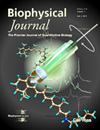Biophysical Mechanisms of SARS-CoV-2-Induced Surfactant Inhibition.
IF 3.1
3区 生物学
Q2 BIOPHYSICS
引用次数: 0
Abstract
Surfactant replacement has been studied as a supportive therapy for managing COVID-19-induced acute respiratory distress syndrome (ARDS). The clinical applications require biophysical understanding of the molecular mechanisms behind SARS-CoV-2-induced surfactant inhibition. While SARS-CoV-2 is known to attack alveolar type II epithelial cells, it is unknown whether the virus can directly interact with the pulmonary surfactant film adsorbed at the alveolar surface. The virus utilizes its spike (S) protein, consisting of two functional subunits (S1 and S2), to bind to the host cell membrane and mediate subsequent membrane fusion. We hypothesize that these two subunits may differentially interact with pulmonary surfactant, resulting in distinct effects on surfactant inhibition. The biophysical impact of recombinant S1 and S2 subunit proteins on a bovine-extracted natural pulmonary surfactant film was investigated with combined constrained drop surfactometry and atomic force microscopy. Our findings revealed that the S2 subunit, in contrast to the S1 subunit, selectively induces surfactant inhibition, evidenced by its capacity in reducing dynamic surface activity and causing domain fusion in surfactant monolayers. These results contribute novel insights into the biophysical mechanisms underlying surfactant inhibition in SARS-CoV-2-induced ARDS, and may hold translational implications for advancing surfactant therapy to manage COVID-19.sars - cov -2诱导表面活性剂抑制的生物物理机制
表面活性剂替代作为治疗covid -19诱导的急性呼吸窘迫综合征(ARDS)的支持疗法进行了研究。临床应用需要从生物物理学角度理解sars - cov -2诱导表面活性剂抑制的分子机制。虽然已知SARS-CoV-2会攻击肺泡II型上皮细胞,但尚不清楚该病毒是否能直接与肺泡表面吸附的肺表面活性物质膜相互作用。病毒利用由两个功能亚基(S1和S2)组成的刺突(S)蛋白与宿主细胞膜结合并介导随后的膜融合。我们假设这两个亚基可能不同地与肺表面活性剂相互作用,导致表面活性剂抑制的不同效果。采用约束滴法和原子力显微镜联合研究了重组S1和S2亚基蛋白对牛提取的天然肺表面活性剂膜的生物物理影响。我们的研究结果表明,与S1亚基相比,S2亚基选择性地诱导表面活性剂抑制,这可以通过其降低表面活性剂单层的动态表面活性和引起结构域融合的能力来证明。这些结果为表面活性剂抑制sars - cov -2诱导的ARDS的生物物理机制提供了新的见解,并可能对推进表面活性剂治疗治疗COVID-19具有转化意义。
本文章由计算机程序翻译,如有差异,请以英文原文为准。
求助全文
约1分钟内获得全文
求助全文
来源期刊

Biophysical journal
生物-生物物理
CiteScore
6.10
自引率
5.90%
发文量
3090
审稿时长
2 months
期刊介绍:
BJ publishes original articles, letters, and perspectives on important problems in modern biophysics. The papers should be written so as to be of interest to a broad community of biophysicists. BJ welcomes experimental studies that employ quantitative physical approaches for the study of biological systems, including or spanning scales from molecule to whole organism. Experimental studies of a purely descriptive or phenomenological nature, with no theoretical or mechanistic underpinning, are not appropriate for publication in BJ. Theoretical studies should offer new insights into the understanding ofexperimental results or suggest new experimentally testable hypotheses. Articles reporting significant methodological or technological advances, which have potential to open new areas of biophysical investigation, are also suitable for publication in BJ. Papers describing improvements in accuracy or speed of existing methods or extra detail within methods described previously are not suitable for BJ.
 求助内容:
求助内容: 应助结果提醒方式:
应助结果提醒方式:


